| | Results of the study
Organic carbon and nitrogen
Analysis of soil organic matter (SOM), conducted on the AESA Soil Quality Benchmark sites, has revealed some significant differences in the per cent of organic carbon and total nitrogen in Alberta™s agricultural ecoregions, depending on soil horizon and slope positions. In ecoregions located further north in the province, the per cent of organic carbon in topsoil generally increased. The per cent of organic carbon in subsoil was higher in ecoregions that had greater below-ground plant productivity. The per cent of nitrogen in both topsoil and subsoil were higher in ecoregions that had higher levels of soil organic matter. Organic carbon and nitrogen levels increased at downslope locations in all ecoregions. Because SOM varies between ecoregions, and within a single field based on slope position, the assessment of SOM is very site-specific. The study findings highlight the importance of conserving high SOM levels in soils and identify some ways farmers can do this.
What is soil organic matter?
Soil organic matter is primarily plant residues, in different stages of decomposition. The accumulation of SOM within soil is a balance between the return or addition of plant residues and their subsequent loss due to the decay of these residues by micro-organisms. SOM is found naturally in all Alberta soils, in small quantities (0 - 17% in mineral soils), though the amount of natural SOM varies considerably from place to place.
Why is SOM important?
SOM is important because it improves both the physical and chemical properties of soil and has several beneficial effects on agricultural soil quality. SOM helps stabilize soil particles, thus decreasing erosion. It also improves soil structure and workability, enhances aeration and water penetration, increases water-holding capacity, and stores and supplies nutrients for growth of both plants and soil micro-organisms.
What factors influence the amount of SOM?
Climatic conditions, such as temperature and rainfall, exert a major influence on the amount of organic matter found in soil. Typically, accumulation of organic matter in soil is greater where there is more precipitation and cooler temperatures. Decomposition of organic matter is greater in warmer, drier climates. Other factors that affect the rate of organic matter decomposition include soil aeration, pH level, and the microbial population of the soil.
Agricultural management practices can also influence the amount of SOM. Increased tillage of the soil decreases organic matter. Tillage increases aeration, which leads to drier soils and greater rates of decomposition. Increased summerfallow in crop rotation also decreases SOM, because fewer plant tissue residues are being returned to the soil.
Fertilization increases SOM because it increases productivity and therefore adds plant residues. Increased use of manure and other soil amendments has a similar affect. Increased use of forages in crop rotations increases SOM because forages leave more residues than other crops. Irrigation can increase SOM because it increases productivity and leads to greater soil moisture. Increased erosion, caused by runoff and other factors, decreases SOM because the soil particles richest in organic matter are usually transported most readily.
Alberta Agriculture Food and Rural Development (AAFRD) has published an AGRI-FACTS handout on Soil Organic Matter (Agdex 536-1) that describes in greater detail the importance and management of SOM.
Soil quality benchmark project
In 1998, Alberta Environmentally Sustainable Agriculture (AESA), in conjunction with the province's agri-food industry, initiated a program to identify and monitor the impacts of agriculture on soil resources and to collect soil information to help develop environmentally sustainable agricultural practices. The program established 43 soil quality benchmark sites, located on typical farm fields throughout the province's agricultural areas (Figure 1). One phase of the program was to determine and compare soil organic carbon (OC) and total nitrogen (N) levels among Alberta's ecoregions.
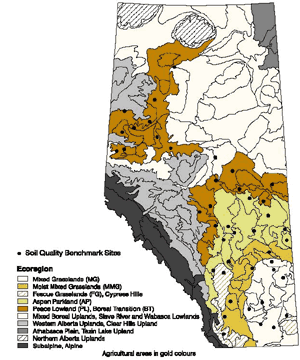
Figure 1. Locations of Soil Quality benchmarks, Ecoregions and Ecodistricts in Alberta
Sampling methods at the benchmark sites
Samples were collected at three slope positions - upper, mid and lower - to determine differences within a given field. Samples were collected from topsoil (the A horizon), subsoil (top of the B horizon) and from the parent geological material (the C horizon). Samples collected from the topsoil and subsoil were analysed to determine the percent of organic carbon and nitrogen and the ratio between the two. Total organic carbon values for topsoil and the soil profile to one metre depth were calculated from organic carbon percentages, horizon depths and bulk densities.
About organic carbon
Organic carbon (OC) is an essential part of all organic compounds. Soil organic matter generally contains approximately 56% OC. The following equation is used to estimate the total organic matter content of soil from OC measurements: % Organic Matter = % Organic Carbon x 1.78
Results of the Study
Topsoils
The soil benchmark study showed the percent of OC in topsoils was different among the six ecoregions (Figure 2).
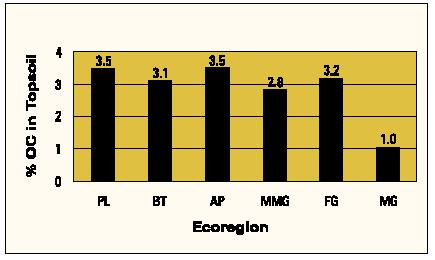
Figure 2.
Topsoils in the Mixed Grassland Ecoregion had the lowest percent OC. The further north the benchmark sites were located, the greater was the percent of OC in topsoil. The higher soil moisture levels and cooler temperatures in the northern parts of the province resulted in greater accumulations and slower decomposition of SOM. The greater use of forages in crop rotations and the lower use of summerfallow in the north may also be contributing factors in the pattern of OC percentages in the soil.
Past agricultural practices typical of the Mixed Grassland Ecoregion may have affected the levels of SOM in this area. Fertilizing at lower rates and using crop/fallow rotations to conserve soil moisture may have resulted in less crop residue being returned to the soil and less SOM being accumulated.
The benchmark study also showed the percent of OC in topsoil was equal to or slightly higher than previously reported averages for cultivated topsoils within each ecoregion (Table 1).
Table 1. Typical SOM Levels in Cultivated Soils
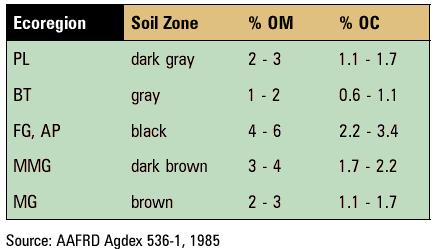
The study also showed the percent of OC in topsoils in all the ecoregions was influenced by slope position. On lower parts of slopes, the percent of OC in topsoils was greater than at the upper and mid slope positions. The increases in organic matter at the lower slope positions were primarily due to their higher crop productivity and slower decomposition. To a lesser extent, the increase in the percent of OC at lower slope positions may be due to topsoil accumulation caused by wind and water erosion and soil displacement from mechanical tillage. These processes result in the accumulation of organic carbon-rich topsoil in low-lying areas (Figure 3) across the province.
Subsoils
In subsoil, the percent of OC was also different among the ecoregions. Instead of progressively increasing in ecoregions located further north, OC percentages in subsoil appear to be higher in the Peace Lowland, Aspen Parkland, Moist Mixed Grassland and Fescue Grassland ecoregions.
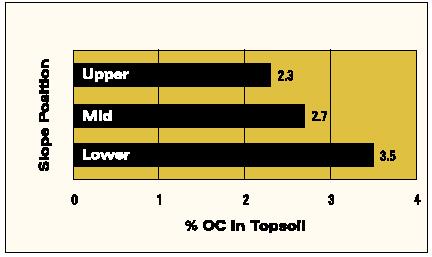
Figure 3.
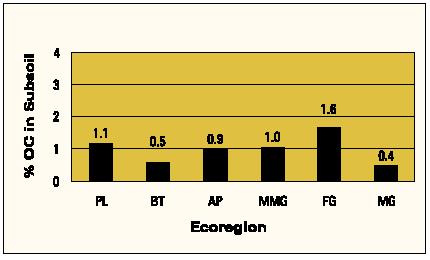
Figure 4.
These ecoregions are located in optimal climatic zones for production and crops have deeper root penetration and greater root biomass than crops grown in the Mixed Grassland ecoregion. These roots eventually decompose and add organic matter to the subsoil. Soils in the Boreal Transition ecoregion also have few moisture restrictions for crop growth, but historically, these soils were treed and more organic matter accumulated on the surface than in the subsoil.
Soil profile
The pattern of OC percentages in the overall soil profile to one metre depth are similar to the pattern of OC in topsoils, with the exception of the Peace Lowland Ecoregion (Figure 5). The percent of OC in the soil profile was highest in the Peace Lowland, whereas the percent of OC in topsoil was highest in the Aspen Parkland ecoregion. Ecoregions in the north have more OC, deeper in the profile, due to more extensive root systems, greater crop productivity, less decomposition, and more moisture, compared to southern ecoregions. Source: AAFRD Agdex 536-1, 1985.
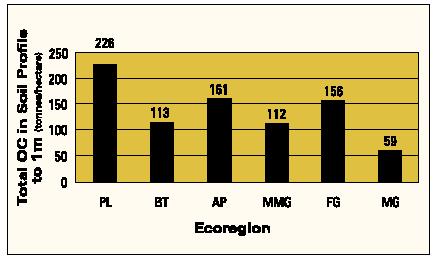
Figure 5.
As in other aspects of the study, organic carbon in the soil profile was greatest at the lower slope positions and decreased upslope.
About Nitrogen
Nitrogen (N) is absorbed from soil and used by plants in its inorganic form, as either nitrate (NO 3- ) or ammonium (NH4 + ). Both forms occur naturally in soils and are common components of inorganic fertilizers. Nitrate is the principal form in which nitrogen is taken up by plants, due to its mobile nature and greater abundance than ammonium. However, inorganic N represents only 2 to 5% of the total nitrogen in the soil. Most soil N is bound to organic matter and not readily available to plants. Total nitrogen (TN) is a measure of both inorganic and organic forms of nitrogen and is expressed as a percentage. Levels of N vary with temperature and moisture in the same way as levels of SOM, that is, N increases with cooler temperatures and more moisture.
Topsoils
The study showed the percent of total N in topsoil in Alberta's ecoregions reflected the amount of SOM within each ecoregion. As the percent of OC increased, so did the percent of N (Figure 6). This confirms that the majority of N in soils is closely associated with SOM and emphasizes the importance of conserving and maintaining this organic matter.
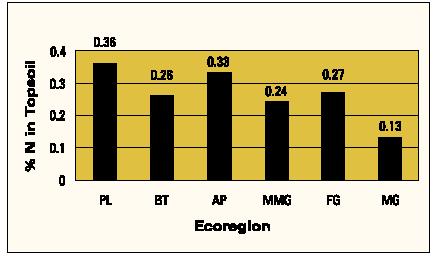
Figure 6.
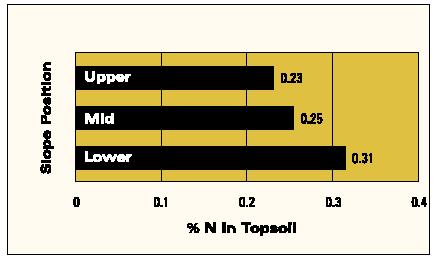
Figure 7.
The percent N in topsoil increased downward along slopes in all ecoregions (Figure 7). The increase reflected higher OC percentages in topsoil at the lower slope positions, due to the accumulation of richer organic matter in low-lying areas.
Subsoils
Ecoregions with higher OC levels in subsoil, had higher levels of N in the subsoil (Figure 8).
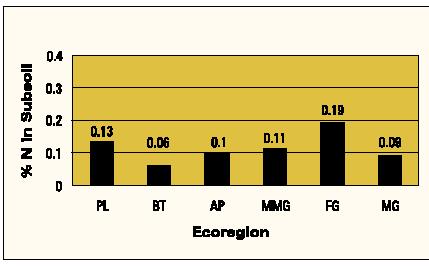
Figure 8.
Carbon - Nitrogen ratios
A close relationship exists between carbon and nitrogen (C:N) levels of soils. The C:N ratio of arable topsoil ranges from 8:1 to 15:1, though it usually falls between 10:1 and 12:1. The variations that occur in these ratios are generally related to climatic conditions. Soil C:N ratios tend to be lower in arid regions than in humid regions, when annual temperatures are about the same. Soil C:N ratios are also lower in warmer regions than in cooler ones, if rainfall is equal. The C:N ratio is generally lower in subsoil than in topsoil.
Carbon to nitrogen ratios of different plants and farm materials vary greatly, ranging from 15 to 30:1for legumes and farm manures, to a high of 100:1 for straw residues. If plant residues with high C:N ratios are added to the soil, decaying micro-organisms will immobilize the ammonium and nitrate and help decompose the SOM. However, if material added to soil contains more N in proportion to C, (lower C:N ratios), there is normally no decrease in mineral N. Carbon to nitrogen ratios of 20 or 30:1 are the dividing line between immobilization and mineralization.
The study results showed C:N ratios for topsoil were slightly lower in the Mixed Grassland Ecoregion, since it is slightly warmer and more arid than the other ecoregions and decomposition is greater (Figure 9).
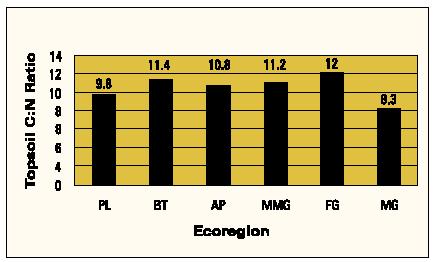
Figure 9.
As expected, subsoil C:N ratios are slightly lower than topsoil C:N ratios for each ecoregion, because there are lower amounts of OC in that horizon.
Implications for field management
Creating and maintaining soil organic matter is vital for improving the physical and chemical properties of agricultural soils. Though SOM is not increased quickly, studies have shown that certain agricultural practices can help farmers increase SOM or reduce the loss of SOM from their fields. The following practices have been shown to be beneficial:
- Use of permanent cover crops and continuous cropping; less use of summerfallow.
- Use of legumes and forages in crop rotations to increase plant residues and SOM.
- The addition of manures to increase SOM.
- Use of fertilizers to increase crop productivity, add plant residues and increase SOM.
- Use of conservation tillage or reduced tillage.
- Better crop residue management.
- Improved erosion control.
- Use of site specific soil testing to determine organic carbon and nitrogen levels. Soil samples should be collected from several different locations on a field to obtain composite and representative samples for analysis.
More information
For further information on soil organic matter conservation and management, contact your local provincial government crop specialist. You may also wish to read The Nature and Properties of Soils (10th edition), by N.C. Brady, published by MacMillan Books in 1990, or Soil Fertility and Fertilizers (5th edition), by Tisdale, Werner, Beaton and Havlin, published by MacMillan in 1993.
For additional copies or more information on this Fact Sheet, refer to FS2001-1SQ. If you have further questions regarding the Soil Quality Benchmark Study, contact:
Jason Cathcart
AESA Soil Quality Program
Resource Sciences Branch
Alberta Agriculture and Food
Phone: 780-427-3432
E-mail: jason.cathcart@gov.ab.ca |
|